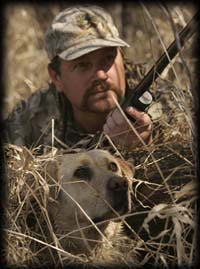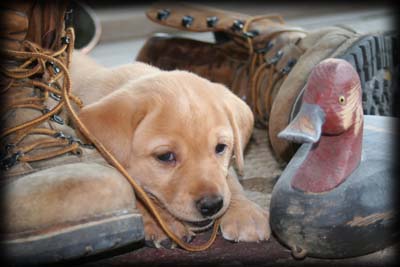|
Tournament Hunter Magazine Article -
Breeding Considerations by Terry
Holzinger
 I’m
often approached by people who are interested in breeding their
dogs. Some are breeders who are seeking to get various qualities
into their lines. Many others are just regular folks who have a
good hunting dog with qualities they would like to see passed
on. These people often have a lot of questions on the do’s and
don’ts of the process. It is important for them to consider
their responsibilities as a breeder and be properly prepared
before breeding their dog. I’m
often approached by people who are interested in breeding their
dogs. Some are breeders who are seeking to get various qualities
into their lines. Many others are just regular folks who have a
good hunting dog with qualities they would like to see passed
on. These people often have a lot of questions on the do’s and
don’ts of the process. It is important for them to consider
their responsibilities as a breeder and be properly prepared
before breeding their dog.
Characteristics
Some of the main things to
consider include the personality of the dog, the physical
characteristics, natural abilities that were bred into the dog
and the proven performance and titles of the breeding dogs and
their bloodlines.
Looking at the personality we
focus on temperament, the part of the personality that is
genetically based; outgoing, tractable nature, eager to please,
non aggressive towards man or dogs, intelligence and very
adaptable. Most people want a dog that is easy to live with but
will hunt hard and love it. Some dogs are a bit lazy and don't
hunt very hard, they only retrieve a few times then get bored.
Other dogs are too excitable and obnoxious and never settle
down. Consider the characteristics you want in a dog and breed
for a good balance in those traits.
Keep in mind while pursuing your
breeding program, the physical characteristics of the breed.
Some people have a different idea of how they would like a dog
built. That is why there are breed standards, to remind us what
distinguishing characteristics each breed should have.
When breeding a hunting dog, the
natural abilities that have been bred into them are very
important. These qualities need to be developed through training
and experience. Here are some key genetic qualities to look for
in your breeding dogs.
- Trainability - quick to learn,
always eager to please and wants to work; good focus
- Strong retrieving drive -
natural soft mouth with a good hold, quick pickup, not
dropping and loves to carry things
- Hunting - quartering or
thoroughly systematically and aggressively hunting an area
- Athletic ability - good muscle
tone and agility for endurance hunting
- Scenting ability is critical —
ground or air scenting, tracking and quickly locating a bird
- Boldness - busting cover and
hitting the water hard
- Perseverance - not giving up
the hunt in tough hunting conditions
- Marking ability - dog see's
and remembers where one or more birds have fallen in a hunting
situation and thoroughly hunts the area where birds have come
down
- Pointing - a strong point
comes from ancestry, holding point as soon as the location of
the bird has been established
Titles
Titles are a way of proving that
a dog has satisfactorily demonstrated he/she can do the task to
the level awarded. Generally it is better to have more proven
titles, especially higher degree titles closer in the pedigree
to your dog. When breeding hunting dogs you want to look for
titles in hunting or field trial programs.(Some dog bloodlines
reproduce their great abilities better than others).
Pre-breeding process
Breeding dogs need to have their
hips and elbows X-rayed and be certified by the Orthopedic
Foundation for Animals (OFA). Elbows should rate as “normal” and
hips preferred “good” to “excellent” for breeding dogs. In
addition eyes should be checked and certified annually by an
animal ophthalmologist and paper work sent to Canine Eye
Registration Foundation (CERF). All responsible breeders' goals
are to help minimize the incidence of genetically caused
problems through the screening of breeding stock within reason.
A wise dog buyer should insist on eye CERF and OFA
certifications of both the sire and dam.
As you do an honest assessment of
your dog’s characteristics you will find some areas that are
weaker. Here you come to the question: Will breeding this dog
help maintain a high quality standard for the breed in the
future? If you can see that the good points far outweigh the bad
and the health clearances are good, then you want to seek out a
stud dog that is especially strong in the areas where your
female is weaker. Work with reputable breeders whose dogs have a
proven history in the types of performance you are most
interested in and consider their recommendations.
Breeding time
Once the decision is made and the
breeding day approaches, the female should have a Brucellosis
test (canine venereal disease), ideally when she first comes
into heat. It can take a couple of days to get the results back
from the vet, so don’t delay. If you’ve had the hips and elbows
OFA'd and eye certifications done, you should be ready to go.
Also some breeders require a progesterone (P4) test to determine
the ultimate time to breed. Be aware that some breeders require
other tests, such as Centronuclear Myopathy (CNM), Exercise
Induced Collapse - a syndrome of Exercise Intolerance and
Collapse (EIC) and Progressive Retinal Atrophy (PRA), etc. Make
certain that you have a complete understanding of their
requirements before your female comes into heat.
Once the female comes into heat,
she is typically ready to breed around the twelfth day of her
heat cycle, but some are ready as early as the seventh day.
Careful, some people don't catch the heat cycle right a way.
Your veterinarian can do smears and progesterone (P4) testing to
determine when she will be ready to breed. The progesterone (P4)
test is the most accurate. This testing will help ensure that
the breeding is successful. Most vets need to send this out to a
laboratory for an accurate reading and it may take a day or two
to get results back. The closer the breeding time the more
accurate the progesterone test will be. Depending on timing,
only (1) breeding may be necessary. Usually (2) breedings at
least 36 hours apart will cover the entire ovulation period. For
a long distance breeding another option may be to send chilled
or frozen semen Fed Ex to the bitch's veterinarian for
artificial insemination.
Selling
It is a good idea to have half
the puppies sold before breeding commences. This will help you
gauge whether there is a real demand for them before you’ve
committed to the responsibility and the expenses involved. The
price you can expect is determined by the cost of the stud dog
(which is determined by his lineage, titles, performance and the
performance of his offspring) and the lineage, titles, and
performance of the female. Good old supply and demand comes into
play here. Dogs with good bloodlines, proven performance and a
good reputation will bring buyers from afar, increasing the
demand and value of the pups.
I also recommend interviewing the
people before making a sale. Try to make certain that your puppy
is going to a good home and that they really want the kind of
dog that you are selling.
When selling quality puppies it’s
important to have a written guarantee that is fair to both buyer
and seller. Once you have written your guarantee, it is a good
idea to show it to someone with a good reputation in the
breeding business. They can look it over for things you may have
missed or areas that need to be better covered.
Whelping
Keep checking your female, when
her temperature drops from a normal 102 degrees down to 99
degrees and holds fairly steady, she will usually start whelping
puppies within 24 hours. The puppies are usually born around
62-63 days after the first breeding, although there is some
variability. Once the pups are born, you should consider having
their dewclaws removed at 2-5 days old. Puppies should be done
with the weaning process by around (5) weeks old so they are on
a regular diet when it’s time to send them off to their new
homes.
 Raising Raising
Spend a lot of time with the
puppies, especially in the last few weeks. Take them for short
walks and let them explore and learn about the world around
them. The puppies should be familiar with people and associate
humans with having lots of fun. Find toys they like to pick up
and carry around, encourage them to retrieve. Remember their
attention span is very short. While spending time with the pups
you get to enjoy watching their individual personalities
develop. Maintain a good cleaning program for the puppies. This
will make housebreaking easier for the new owners because the
puppies will be used to keeping themselves clean. Raise these
pups the way that you would want someone to raise a pup for you.
Sending Home
I like to send them off around 7
weeks (49 days). Seeing people getting excited over their new
puppy is always a special time. You should be thrilled knowing
the great potential that was bred into the pup. Things to send
home with the puppies include: Health certificates, a guarantee,
pedigrees of both parents, worming and type of vaccination
information and a little bit of the food they’ve been eating to
avoid a drastic change in diet. It’s also nice to send some
puppy tips home as well. You can go to our web site at
http://holzingerkennels.com/puppies.html and look for the
“Puppy Tips” link at the bottom of the page. There is a
printable file available there that will give the new owners a
good start.
New Home
I like to maintain contact with
the people to follow the progress of our puppies. This feedback
helps you get a good understanding of the kind of dogs you are
actually breeding. Hopefully most of the feedback will be very
positive. Who knows - you might even develop a new hunting buddy
or two from the people who you meet this way.
I hope this answers most of your
concerns, but don’t be afraid to ask the breeder a lot of
questions. It’s a great way to learn from the pros.
Enjoy!
Training |
Breeding |
Stud Dogs |
Puppies |
Photos |
Videos |
Questions |
About Us |
Contact Us
|





